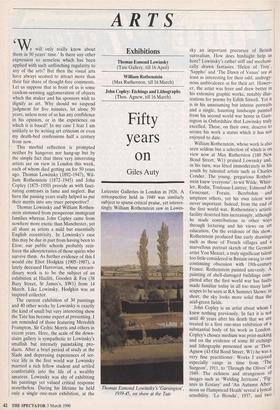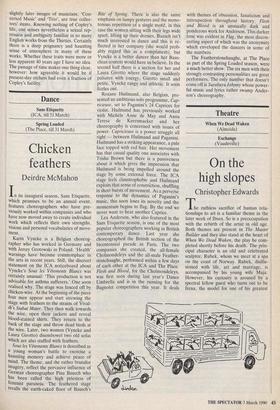ARTS
Exhibitions
Thomas Esmond Lowinsky (Tate Gallery, till 16 April) William Rothenstein (Max Rutherston, till 16 March)
Fifty years on
Giles Auty
We will only really know about them in 50 years' time.' Is there any other expression so senseless which has been applied with such unflinching regularity to any of the arts? But then the visual arts have always seemed to attract more than their fair share of thought-free comments. Let us suppose that in front of us is some random-seeming agglomeration of objects which the maker and his sponsors wish to dignify as art. Why should we suspend judgment for five minutes, let alone 50 years, unless none of us has any confidence in his opinion, or in the experience on which it is based? In my case I fear I am unlikely to be writing art criticism or even my death-bed confessions half a century from now.
This morbid reflection is prompted neither by hangover nor hang-up but by the simple fact that three very interesting artists are on view in London this week, each of whom died getting on for 50 years ago. Thomas Lowinsky (1892-1947), Wil- liam Rothenstein (1872-1945) and John Copley (1875-1950) provide us with fasci- nating contrasts in fame and neglect. But have the passing years really helped us put their merits into any truer perspective?
Thomas Lowinsky and William Rothen- stein stemmed from prosperous immigrant families whereas John Copley came from nowhere more exotic than Manchester, yet all share as artists a mild but essentially English eccentricity. In Lowinsky's case this may be due in part from having been to Eton; our public schools probably rein- force the idiosyncrasies of those spirits who survive them. As further evidence of this I would cite Eliot Hodgkin (1905-1987), a lately deceased Harrovian, whose extraor- dinary work is to be the subject of an exhibition at Hazlitt, Gooden & Fox (38 Bury Street, St James's, SW1) from 14 March. Like Lowinsky, Hodgkin was an inspired collector.
The current exhibition of 30 paintings and 40 other works by Lowinsky is exactly the kind of small but very interesting show the Tate has become expert at presenting. I am reminded of those featuring Meredith Frampton, Sir Cedric Morris and others in recent years. Here, the scale of the down- stairs gallery is sympathetic to Lowinsky's smallish but intensely painstaking pro- ducts. After a brief period of study at the Slade and depressing experiences of ser- vice life in the first world war Lowinsky married a rich fellow student and settled comfortably into the life of a wealthy amateur. Lowinsky was shy of exhibiting his paintings yet valued critical response nonetheless. During his lifetime he held only a single one-man exhibition, at the Leicester Galleries in London in 1926. A retrospective held in 1949 was similarly subject to sparse critical praise, yet interes- tingly William Rothenstein saw in Lowin- Thomas Esmond Lowinsky's `Garsington', 1939-45, on show at the Tate sky an important precursor of British surrealism. How does hindsight help us here? Lowinsky's rather stiff and mechani- cally drawn fantasies 'Helen of Troy', 'Sappho' and 'The Dawn of Venus' are at least as interesting for their odd, androgy- nous ambivalence as for their art. Howev- er, the artist was freer and drew better in his extensive graphic works, notably illus- trations for poems by Edith Sitwell. Yet it is in his unassuming but intense portraits and a single, haunting landscape painted from his second world war home in Garsington in Oxfordshire that Lowinsky truly excelled. These, on their own, deserve to secure his work a status which it has not enjoyed to date.
William Rothenstein, whose work is also seen seldom but a selection of which is on view now at Max Rutherston (180 New Bond Street, W1) praised Lowinsky and, in his turn, was feted immoderately in his youth by talented artists such as Charles Conder. The young, gregarious Rothen- stein knew 'everyone', to wit Wilde, Whist- ler, Rodin, Toulouse-Lautrec, Edmond de, Goncourt, Forain, Beerbohm and umpteen others, yet his own talent was never important. Indeed, from the end of the first world war, Rothenstein's artistic facility deserted him increasingly, although he made contributions in other ways through lecturing and his views on art education. On the evidence of this show, Rothenstein produced fine early drawings such as those of French villages and a marvellous portrait sketch of the German artist Von Menzel, a truly significant talent too little considered in Britain owing to our continuing obsession with 19th-centurY France. Rothenstein painted unevenly. A painting of shell-damaged buildings com- pleted after the first world war has faults made familiar today in all too many land- scapes to be seen at RA Summer Shows: in short, the sky looks more solid than the acid-green fields. John Copley is an artist about whom I knew nothing previously. In fact it is not until 40 years after his death that we are treated to a first one-man exhibition of a substantial body of his work in London. Copley's chosen medium was print-making and on the evidence of some 80 etchings and lithographs presented now at Thos. Agnew (43 Old Bond Street, W1) he was a very fine practitioner. Works I enjoyed especially range in time from 'The Surgeon', 1911, to 'Through the Olives' of 1949. The richness and strangeness of images such as 'Welding Jerricans', 'Fig- ures in Ecstasy' and 'An Autumn After- noon on Hampstead Heath' reveal a lyrical sensibility. 'La Bionda', 1937, and two
slightly later images of musicians, 'Con- certed Music' and 'Trio', are true collec- tors' items. Knowing nothing of Copley's life, one senses nevertheless a sexual rep- ression and ambiguity familiar in so many English works from the Thirties. Certainly there is a deep poignancy and haunting sense of atmosphere in many of these works. Whether these traits were more or less apparent 40 years ago I have no idea. The passage of time makes one thing clear, however: how agreeable it would be if present-day etchers had even a fraction of Copley's facility.



























































 Previous page
Previous page